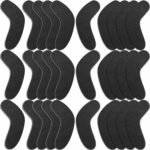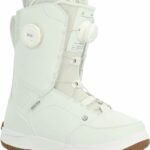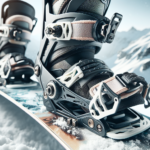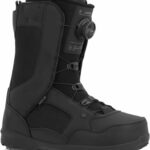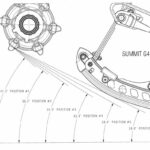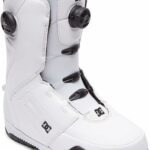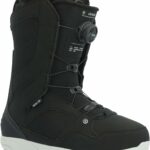You’ve finally decided on the perfect snowboard, now it’s time for the next critical component – the boots. In the article “How Should A Snowboard Boot Fit?” you’ll find beneficial insights to help you navigate the complex world of snowboard boot fitting. Because, when it’s about snowboarding, the comfort, control and performance your boots deliver can significantly impact your overall experience. So, it’s crucial that you understand the importance of a proper fit – not too loose, not too tight, but a glove-like comfort that makes your ride smooth and effortless.
Understanding the Importance of Proper Snowboard Boot Fitting
Snowboarding is an exciting and challenging pastime, but to truly enjoy the ride, you need to have the right gear, especially when it comes to your snowboard boots. A lot of people tend to underestimate the importance of well-fitted snowboard boots, not realizing that it’s these boots that, after your board and bindings, have the greatest impact on your snowboarding performance and comfort.
Significance of Appropriate Boot Sizes
So you’ve got yourself a snowboard and are ready for the slopes. But the boots you wear can either make or break your snowboarding experience. Too loose, and your feet may slide causing imbalance and falls. Too tight, and your day might end prematurely due to pain and discomfort. Finding that perfect fit is imperative to a smooth ride down the mountain. Not to mention, finding boots that fit correctly will also help you improve your skills more effectively.
Impact of Incorrectly Fitted Boots on Snowboarding Experience
An incorrectly fitted boot can significantly mar your snowboarding experience. Boots that are too large might lead to inefficient energy transfer, making control of the board more challenging. On the other hand, boots that are too small can cause discomfort and may lead to cold feet due to restricted blood flow. They might also cause bruising, blisters or even more serious foot injuries.
Injury Prevention through Correct Boot Fitting
Properly fitted snowboard boots can play a key role in preventing injuries. When your boots fit correctly, they provide necessary ankle support and cushion against impact, significantly reducing your risk of sprains or fractures. They also hold your foot in place, preventing it from moving and banging against the boot shell, which is a common cause of bruises and blisters.
Deciphering Snowboard Boot Sizes
Picking out the correct size for your snowboard boots is a bit more complicated than simply knowing your shoe size. Here’s some help:
Understanding Snowboard Boot Sizing Terminology
Just like regular shoes, snowboard boots come in sizes that represent the length of your foot in either inches (US sizes) or centimeters (European sizes). The sizes can also vary from men’s to women’s. The ‘Mondo Point’ sizing system, which represents the length in centimeters, is used by many manufacturers.
Conversion of Traditional Shoe Sizes to Snowboard Boot Sizes
If you’re unsure of your size, a good starting point can be to take your normal shoe size and convert it into the Mondo system. For instance, if you normally wear a size 9 US men’s shoe, your boot size would be approximately a 27 in Mondo sizing. However, this is just a starting point and actual fit may vary.
Considerations for Different Brands and Models
Remember, different brands and models have varying fits. Some boots run smaller or larger than the standard sizes, and the shape of different models can vary widely. This is why it’s important to try them on before making a purchase.
Steps for Proper Measurement of Foot Size
If you want to get a good fit, taking a proper measurement of your foot is critical. Here’s how:
Understanding Appropriate Measurement Techniques
You’ll need a blank sheet of paper, a pen, and a ruler for this. Stand on the paper with your heel against the wall, and mark the spot at the farthest point of your foot. Measure this length in cm and convert to Mondo Point to get your boot size.
Getting Accurate Foot Measurements
Keep in mind that measurements can vary slightly based on the time of day and activity level. So, if possible, try to measure your foot later in the day and after some activity, as feet can swell.
Importance of Measuring Foot Length, Width and Arch Length
While the length of the foot is an important factor, the width of your foot and the length of your arch can also have an impact on the fit of your snowboard boots. A common mistake is to only focus on the length, but other factors should also be taken into account for a perfect fit.
Determining the Right Snowboard Boot Flex
Snowboard boot ‘flex’ is crucial, especially depending on your snowboarding style and experience. Navigate your way through the different types to find the best match for you.
Different Types of Boot Flex
Boot flex is usually graded on a scale of 1-10, with 1 being the softest and 10 the stiffest. Soft flex boots are more comfortable and forgiving, making them ideal for beginners or freestyle riders. Medium flex boots are great for all-mountain snowboarding, offering a balance between responsiveness and comfort. Stiff boots are suitable for free-riders and advanced snowboarders who demand maximum control and precision.
Choosing the Right Flex Based on Skill Level
As a beginner, you might prefer a softer boot that will allow you to comfortably master your basic skills. But as you become more advanced and start trying different styles, you’ll likely gravitate towards a stiffer boot that offers more precision and control.
Influence of Flex on Comfort and Performance
Too soft, and your boot may not offer the support or precision you need, and too stiff could potentially limit your motion and cause discomfort. Striking the right balance is key for both comfort and performance.
Considering the Snowboard Boot Liner
A crucial yet often overlooked aspect of snowboard boots is the liner. This inner boot can greatly influence how comfortable your boots are and how well they perform.
Explaining the Role of Boot Liners
The primary role of boot liners is to provide cushioning and insulation. They also help to secure your foot and ankle, enhancing your control over the board. In essence, a good liner can make a world of difference in your snowboarding experience.
Finding the Correct Liner Thickness and Material
Liners come in different thicknesses and materials. More experienced riders often lean towards thinner liners for more precise control, while beginner or all-mountain riders might prefer thicker liners for comfort. The material can also affect the warmth of the boot.
Understanding Liner Molding and Personalized Fit
Many modern liners are heat-moldable, meaning that they will mold to the unique contours of your foot over time, providing a customized fit. This significantly enhances comfort and control and is a feature worth considering.
Assessing the Snowboard Boot Fit in Store
When you’re buying boots in a store, there are a few important things to consider to ensure you make a good choice.
Trying on the Boots Correctly
Here’s the right way to do it. Loosen the boot fully and slip your foot in. Take a moment to let your foot settle before tightening the laces. Remember, your boots should feel snug but not painful.
Key Areas to Check for Fit and Comfort
Pay special attention to the heel area – your heel should feel secure with no lift. Your toes should touch the boot’s end but not crunched. Also, ensure that there aren’t any pressure points or areas of discomfort.
Common Mistakes when Trying on Snowboard Boots
One common mistake is to choose boots that are too big. Bigger boots may feel comfortable in the store, but they will pack out and become too roomy after some use. Also, be mindful of walking around in the boots in the store to get a feel for them, as walking and snowboarding are different movements.
Snowboard Boot Lacing Systems
The lacing system of your boots plays a crucial role in comfort and ease of use.
Introduction to Various Lacing Systems
There are three main types of lacing systems: traditional, boa, and speed lace. Traditional lacing gives many options for customization but takes a bit longer to put on and adjust. Boa systems offer swift and effortless adjustment, while speed lace systems provide speedy and easy micro-adjustments.
Pros and Cons of Different Lacing Techniques
Each lacing system has its pros and cons depending on the rider’s style, skill, and personal preference. Do some research and try different systems to find the one that suits you best.
Choice of Lacing System Influencing Boot Fit
The lacing system can greatly affect the fit and feel of your boot. A poorly laced boot can result in a subpar fit, discomfort, and decreased performance, while a well laced boot can enhance fit, comfort, and performance.
Periodic Evaluation of Snowboard Boot Fit
Just like everything else, snowboard boots are subject to wear and tear. This naturally leads to changes in fit over time. Here’s how to manage that:
Factors Contributing to Change in Boot Fit Over Time
Factors such as liner pack-out, wear of outsoles, and changes in your foot size or shape can contribute to a change in boot fit over time. Regular checks and maintenance are needed to ensure that your boots continue to fit and function well.
When to Consider Replacing Snowboard Boots
When your boots become uncomfortable, begin to fall apart, or are no longer providing the support and performance you need, it’s time for a new pair. It’s better to replace worn-out boots than to risk injury or have a poor snowboarding experience.
Taking Into Account Snowboarding Frequency and Intensity
The frequency and intensity of your snowboarding will greatly influence how long your boots last. Someone who boards every weekend and is quite aggressive on their gear might need new boots every season, while a less frequent or light user could get several seasons out of their boots.
Dealing with Common Fit Problems
In spite of your best efforts, you may still encounter some fit problems with your snowboard boots. Here’s how to deal with them:
Identifying Frequent Snowboard Boot Issues
Common issues include heel lift, toe crunch, and pressure points. All of these can cause discomfort and hamper your performance on the slopes.
Tips for Addressing Common Fitting Concerns
There are many remedies to common fitting issues, from adjusting your lacing to adding aftermarket insoles or heel grip pads. But if you’re dealing with persistent problems, it might be time to consult a professional.
When to Seek Professional Assistance for Fit Troubles
If despite your efforts, you’re still experiencing fit issues and discomfort, don’t hesitate to seek help from a boot fitting specialist. They can help diagnose your issue and provide solutions and guidance.
Customizing Snowboard Boots for Optimal Fit
Not finding your perfect …fit? Customization may be the answer!
Overview of Snowboard Boot Customization
Custom boot fitting has gained popularity in recent years, and for good reason. Customizing your boots can greatly enhance comfort and performance by tailoring the boot to the specific needs of your foot and style of riding.
Adjusting Various Boot Components for Better Fit
Many boot components are customizable, from the liner and insoles to the toe box and the cuff. Custom molded liners and insoles can offer a tailored fit to accommodate the exact contours of your feet.
Role of Boot Fitting Specialists
Boot fitting specialists can play a crucial role in ensuring you get the most out of your snowboard boots. They have the knowledge and skills to guide you through the boot fitting process, suggesting adjustments or modifications that will enhance fit, comfort, and performance.
- What Snowboard Bindings Should I Get? - January 23, 2024
- What Size Screws For Snowboard Bindings? - January 23, 2024
- How To Snowmobile On Water? - January 23, 2024

